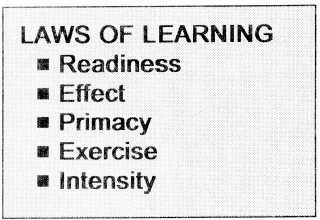| |
their learning on the job. If possible, provide realistic exercises by using the actual (or the same
type of) equipment students will use on the job. The Navy’s damage control team training is
a good example of how this type of learning takes place.
LAWS OF LEARNING
Laws and principles of learning are attempts to
define the fundamental conditions of the
learning process. In general, we have five
almost universally accepted laws of learning.
Each of these laws has common sense
applications based on lessons people have
learned over the years. Your mastery of these
applications will greatly enhance your ability
to influence your students to learn and perform
at a high level.
LAW OF READINESS
According to the law of readiness students learn best when they are physically, mentally, and
emotionally ready to learn. Since learning is an active process, students must have adequate
rest, health, and physical ability. Students who are exhausted or in ill health obviously cannot
learn much. Although these areas are beyond your control, you must know how to address
them in your classroom. For students to be mentally ready to learn, they must master certain
knowledge and skills at one level before they can learn those required at the next higher level.
For example, students who have not learned the basic application of a law have little chance of
applying that law to more complex situations.
Just as students must be ready to learn, you must be ready to teach. Always prepare your
lesson plans, training materials, and classroom or laboratory before you begin to teach. Your
readiness is an important step in gaining the confidence and attention of your students.
Remember, you only get one chance to make a first impression.
LAW OF EFFECT
An individual learns best those things which result in satisfying consequences. Since the law’
of effect has a direct relationship to motivation, it has many practical applications for you in
the training environment.
One of the most basic applications is in your relationship with adult students. Adults want
immediate benefits from training, so begin your instruction by presenting the benefits of the
lesson. Continue to remind students of these benefits throughout the training. Point out the
value of the training in meeting the needs of your students: self-satisfaction, self-confidence,
improved skills, and so forth. Begin each lesson with a statement of objectives to help students
23
|

